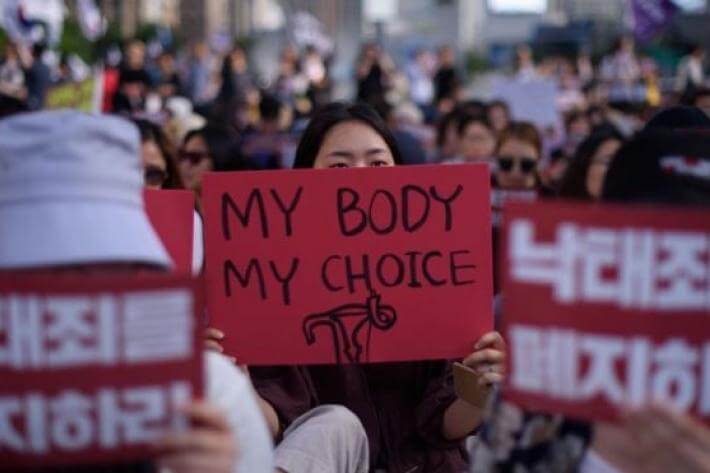Abortion: At What Point Should an Embryo be Considered Capable of Having Feelings, and Should Abortion be Forbidden?

________________________________________________________________________________
This Blog is written by Ruthika Reddy from St. Francis College for Women, Hyderabad. Edited by Prakriti Dadsena.
________________________________________________________________________________
INTRODUCTION
Issues such as women’s sexuality, reproductive health, and fertility are rarely discussed in the mainstream due to society’s patriarchal framework. The term “pro-choice” refers to a woman’s right to choose whether to continue her pregnancy or terminate it through medical procedures. Abortion is the term for the intentional medical termination of a pregnancy. A spontaneous abortion, also known as a miscarriage, occurs when a pregnancy ends on its own, whereas an induced abortion is when a pregnancy is terminated with medicinal or surgical intervention. According to the works of Hypocrites, abortions were prevalent as early as 450 BC. Abortion was allowed only during the first three months of pregnancy in the fourth century AD. Abortions were illegal in many nations from the Middle Ages and until the 1900s. The pro-choice and pro-life (opposing abortion) positions affect society, public affairs, and politics. Abortion is one of the polarizing issues that has sparked a debate in society. There are some societies that have banned abortion completely, and many societies set a maximum age after which a fetus cannot be terminated. Many people often believe that abortion is primarily a moral issue involving the beginning of human personhood, fetal rights, and bodily integrity. Pro-life activists have termed abortion as morally wrong and unjustifiable as it involves harming a life. Furthermore, some ethicists think that, in consideration of the pregnant woman’s rights, we should be able to terminate the fetus whenever she wishes during the pregnancy. It is essentially a clash of values. On one side is the interest of the woman to choose to carry or terminate her pregnancy and on the other side is the interest to protect the foetus, as it evolves from a fertilized egg to an infant. Even if abortion is to be legalized, at what stage of the pregnancy is abortion appropriate and ethical is a harder question to answer.
SIGNIFICANCE OF DEVELOPMENT
The concern for women’s well-being and their rights was the primary motivating force behind the changes in abortion reforms. Women began to fight more actively for their rights in the 1960s, inspired by the civil rights and antiwar movements. The fast-growing women’s movement brought the hitherto taboo topic of abortion to the public eye. Women burdened by years of secrecy came forward to speak about their illegal abortions, erupting in rage, pain, and fear in marches and demonstrations. In most nations around the world, women’s access to safe and legal abortions is restricted by law or in practice. Women considered it their moral right to do what they want with their bodies and their right to abortion, a step towards gender equality. Moreover, it was believed that the existing laws against abortion would threaten the lives of many women who have become pregnant accidentally, forcing them to bear unwanted children or seek illegal abortions. Illegal abortion is unsafe, life-threatening, and a leading cause of maternal mortality. The restrictive laws on abortion are a form of discrimination against women.
IMPACT
More than 50 nations have amended their laws to allow for greater access to abortion in the last 25 years, thereby recognizing the critical role that safe abortion plays in preserving women’s lives and health. Women experienced fewer complications as risky, illegal abortions were replaced by safer, legal procedures. There is strong evidence that the legalization of abortion resulted in a reduction in the number of births to women under the age of 21. As legal abortions became more widely available, the number of women treated in emergency rooms and hospitals for septic abortion complications decreased considerably. Women became conscious and aware of their rights. Moreover, the legalization of abortion also came as relief to women suffering from severe health conditions who wish to terminate their pregnancy.
STATUTORY PROVISION
The laws governing abortion in India are:
The Indian Penal Code, 1860
According to the Indian Penal Code of 1860, induced abortion is banned in India, considering the social, emotional, and medical implications of abortion. Abortion is defined as “causing miscarriage” in Section 312 of the Indian Penal Code of 1860. It applies to a woman who intentionally carries out a miscarriage. The IPC however does not lay down any legal provisions related to abortion.
Medical Termination of Pregnancy Act, 1971
This act lays down the provisions of abortion laws in India and it is also known as the abortion act in India. The act states that you can terminate a pregnancy with the consent of a medical practitioner up until the first 12 weeks. It also states that the approval of two medical practitioners is necessary for abortions between 12 and 20 weeks of pregnancy. Also, the act specifies who is a registered medical practitioner and where the pregnancy termination shall take place. The act says that medical opinion must be given in “good faith”.
According to this act, to perform an abortion, the doctor must have one of the following qualifications:
• A registered practitioner who has performed at least 25 medically assisted pregnancy terminations in India.
• A surgeon with six months of obstetrics and gynecology experience.
• A person with a diploma or a degree in obstetrics and gynecology.
• A doctor who was registered prior to the MTP Act’s implementation in 1971 and has three years of obstetrics and gynecology expertise.
No pregnancy termination shall be performed in compliance with this Act anywhere other than –
• A hospital founded or maintained by the government, or
• a location already approved by the government for the purposes of this Act.
The Constitution of India
The Indian Constitution discusses the concept of abortion, although it is vague and unclear. If the right to abortion is subjected to interpretations, it may fall under Article 21. The right to life and personal liberty is guaranteed by Article 21. It is also understandable that a woman who has been granted such a right would exercise her own freedom and change her body in any way she sees fit.
CASE LAWS
Mrs X v. Union of India
In this case, the apex court granted permission to terminate a 22-week-old pregnancy based on a medical board’s assessment that the woman’s physical and mental health would be affected if the pregnancy was continued. The Supreme Court’s recognition of a woman’s right to terminate her pregnancy is particularly significant in this case. The Court ruled that “a woman’s right to make reproductive choices is also a component of her ‘personal liberty’ according to Article 21 of the constitution”.
Savita Sachin Patil v. Union of India
In this case, a 27-week pregnancy was prayed for to be terminated due to the foetus’ serious physical abnormalities. The Supreme Court shockingly refused termination of pregnancy, citing a medical board’s report which stated that, while the foetus had physical anomalies, there was no harm to the mother’s physical health.
Murugan Nayakkar v. Union of India & Ors
In this case, the Supreme Court granted permission for the termination of a 13-year-old rape victim’s 32-week pregnancy. Considering the petitioner’s age, the trauma she has suffered as a result of the sexual abuse, and the agony she was going through, the court considered it appropriate for the termination of the pregnancy.
ANALYSIS AND CONCLUSION
In my opinion, an embryo cannot be considered a human being as it is only a complex of cellular elements. A foetus of 15 weeks or more can also be referred to as a human being. At this stage, the baby develops its organs and they start functioning. It means that at the end of the first trimester the embryo starts developing and can be considered capable of having feelings from this stage onwards, as human life starts to develop in this stage. Abortion should not be completely forbidden as it violates the rights of women. Keeping in mind their bodily rights, it is important to decriminalize abortion, thereby providing them access to legal and safe abortions. However, abortions should be allowed only until 20 weeks of pregnancy as life starts developing from this stage. Scientific studies also report that foetuses start to feel pain after 20 weeks. However, abortions should be allowed after this period only if the foetus has severe physical anomalies, if the continuation of the pregnancy severely affects the mother’s physical or mental health or if the pregnancy is due to sexual assault or rape. Until the prescribed time limit of 20 weeks, the woman should have the sole right to determine if she wishes to terminate her pregnancy. Although it is difficult to be precise, the proper answer might be to recognize that there are degrees of right to life and that the foetus’s right to life grows stronger as it develops. This response is important because it reflects how many people feel about abortion: the more developed the foetus is, the more uncomfortable they are about aborting it, and the greater weight they place on the unborn’s rights over the mother’s rights.
REFERENCES
(1) https://www.ncbi.nlm.nih.gov/pmc/articles/PMC3713799/
(2) BBC – Ethics – Abortion: When is the foetus ‘alive’?
(3) https://www.reproductiverights.org/sites/default/files/documents/pub_bp_safeandlegal.pdf
(4) http://www.bbc.co.uk/ethics/abortion/mother/introduction.shtml

